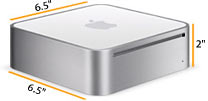 Apple continues to replace their products’ CPUs with new Intel processors, today unveiling Mac minis powered by the Intel Core Solo and Core Duo. (See product page, full specs from Apple.)
Apple continues to replace their products’ CPUs with new Intel processors, today unveiling Mac minis powered by the Intel Core Solo and Core Duo. (See product page, full specs from Apple.)
Especially given the price, these look like they’ll be great machines for music production, at least once the software catches up. You won’t want to make the switch until software and plug-ins have been recompiled as Universal binaries for Intel, particularly if this is going to be your primary machine. But when that does happen — many have been announced for release by summer — this should be a blazing machine. As we saw earlier today, benchmarks look promising even for music software that hasn’t been optimized for the dual cores. With software that is optimized for those chips, the dual machine should be even better (and worth the extra money). I’m especially interested in Apple’s own Logic Pro and upcoming releases of Ableton Live and Max/MSP/Jitter. And you can rack-mount Mac minis, as pictured.
![]()
Updated: Via the Quartz Composer dev list: in fact the Intel i950 graphics chip on the new Mac minis will support Core Image and Quartz Express, and should perform better than the previous mini’s bare-bones ATI 9200 chip. I would still opt for a more expensive system, though, if you’re serious about live 3D graphics — the iMacs, MacBook Pros, and Power Macs all have more sophisticated graphics capabilities. -PK
For most music users, the mini will be just fantastic:
Here’s my one caveat: there’s not a dedicated graphics card on the new mini, as with the previous mini’s ATI Radeon 9200. While you should be able to run CPU-native video quite nicely on this machine, including HD H.264 video, and a DVI out makes it perfect as a home entertainment machine, the integrated, shared Intel video processor won’t cut it for 3D applications. That means everything from 3D motion graphics apps (Apple Motion) to 3D gaming to live 3D visuals with Quartz Composer or Max/MSP/Jitter are out. Admittedly, this is a smaller segment of the readership here, but you know who you are. (Incidentally, this combined with the more backwards-compatible PowerPC chip on the “legacy” mini means you might want to watch for fire sale prices. If you’re looking for a bargain machine anyway, why not? I’d buy up a $300 G4 mini.)
Previously:
Rack-Mounted Mac Mini Keyboard/Guitar Rig with LCD (Part I)
Live Mac Mini Rig, Pt. II: Logic Environment for Live Performance
Musical Mac Mini: Custom Analog Synth